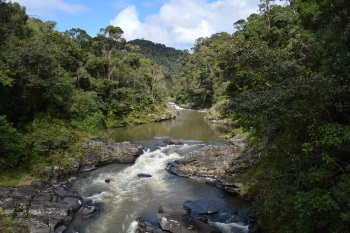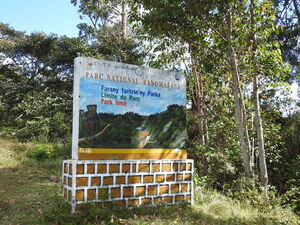Rainforests of the Atsinanana

The Rainforests of the Atsinanana are recognized for their very high biodiversity and high level of endemism in both plants and animals.
These are the remaining forests in which Madagascar's unique biodiversity survives. Most of the island's plant and animal life has evolved in isolation over the past 60 million years; up to 90% of the species found here are endemic. At least 25 species of the wholly endemic Malagasy primates, the lemurs, can be found in the forests. The rainforests are spread across six national parks on steep terrain in the east of the country.
Community Perspective: All reviewers so far have described their visits to Ranomafana NP, the most accessible of the included parks at about a day's drive from the capital. The typical itinerary consists of an evening/night visit (for the nocturnal species), followed by a forest walk the next day for the diurnal ones. Lemur and chameleon sightings will be abundant.
Map of Rainforests of the Atsinanana
Community Reviews
Els Slots

The Rainforests of the Atsinanana are the quintessential Malagasy WHS, as they comprise the last remaining patches of rainforest in Madagascar and are home to the iconic lemurs (of which 108 species have been discovered). Like the other reviewers before me, I choose to visit Ranomafana NP out of the 13 WH locations, as it is the easiest to reach. After 2 days of driving from the capital via Antsirabe along bare red soil and agricultural terraces, suddenly there they were: forests! Even in the dry season, it often rains here at night. More water is present at the river with a large waterfall next to the access road.
I stayed in Ranomafana village for one night; this way you can do the night walk after arrival and visit the diurnal creatures the next morning. You can allocate more time when you’re interested in a specialized subject like birds – the park has three sections, of which the main one holds most lemurs and the other two have their own qualities.
The night walk nowadays is executed along the road parallel to the park entrance - it is forbidden to enter the park borders after dark due to people getting lost / poaching (I heard both stories). I went with a local guide, for whom this side job was a welcome addition to his income as a banana farmer. He had sharp eyes, especially for chameleons, which became the stars of the walk. We saw many species, some tiny and others of a decent size. They did change colour when we looked more up and close, the trick is to then go quickly to look at it from the other side where the original colours are still present.
Lemurs also come in diurnal and nocturnal species. Our aim for the night was the Brown Mouse Lemur. The guides (there was another one present with a tourist couple in tow) use the help of rubbing banana smell to a tree branch – we saw one quickly, but the spot was used mainly by a rat that scared the lemur away. Later on, at a different place, we got eye-shine from the flashlights. Zooming in with my camera it proved indeed to be the mouse lemur, a small creature looking at us with two round eyes.
Around 7.30 the following morning we started the hike inside the park, after having bought a ticket at the reception (no sign of a WH plaque by the way). The ticket shows the Golden Bamboo Lemur, the flagship species of this park. With the guide (in all Malagasy national parks the use of a local guide is obligatory) we went on our way to see some flora but mostly lemurs of course. A tracker walked ahead to scout for these mammals. The main trail inside the park is fairly easy (a bit up and down) and paved with large stone blocks. Unfortunately, the lemurs usually do not come close to the path, although some of them are known to take the recently renovated bridge across the river in the early morning. The species that Ranomafana is especially known for, the various bamboo lemurs, take their breakfast in a patch of dense bamboo forest. When the tracker has found a lemur, you need to scramble up the hill and across tree trunks to get close enough to see them. The whole experience reminded me of Mgahinga NP TWHS in Uganda, where you go and look for Golden Monkeys in a similar bamboo forest.
Fortunately, lemurs are more relaxed around humans and better resistant to noise than monkeys for example. Guides and tracker just shouted out to each other across the forest. And the lemurs kept nibbling away at their bamboo shoots with 6 photographing tourists underneath their tree. We eventually saw three species over the course of 3.5 hours: the critically endangered Greater Bamboo Lemur (looks like a large teddy bear), the also critically endangered Golden Bamboo Lemur, and the less endangered (status: vulnerable) Red-bellied Lemur, which also lives in other parks but is not so commonly seen. These lemur species live as couples or families and are fairly quiet, so they’re not easy to spot by yourself.
Read more from Els Slots here.
Michael Novins

In August 2016, I decided to stop in Madagascar while traveling from Seychelles to Mayotte so that I could visit one of the national parks in the Rainforests of the Atsinanana WHS, which was inscribed in 2007, two years after my first visit to Madagascar. I began my trip in Antananarivo, where I stayed at Palissandre Hotel (http://www.hotel-restaurant-palissandre.com/), which overlooks Analakely Market, the city's largest. The only WHS national park that is within driving distance of Antananarivo is Ranomafana National Park, around nine hours from the capital. On the way, I visited Antsirabe, the country's third largest city, which still has several buildings from French colonial rule, including Hôtel des Thermes (1922) and the railway station (1923). From Antsirabe, it was around six hours to Ranomafana National Park, one of the national parks in the Rainforests of the Atsinanana WHS. During a very muddy morning hike, I saw several lemurs, including Milne-Edwards' sifaka, red-fronted brown lemur, greater bamboo lemur (which was thought extinct until rediscovered in 1986), eastern lesser bamboo lemur and golden bamboo lemur (which was discovered in 1986). During an evening hike, I saw several chameleons, including two-banded chameleon (♂ and ♀ (photo)), O'Shaugnessy's chameleon (♂ and ♀), short-nosed chameleon and side-striped chameleon, and brown mouse lemur.
Solivagant

Madagascan forests provide a wonderful opportunity to see creatures you can see no where else in the world. Not just Lemurs but also other endemics such as the nocturnal “Fossa” or Malagasy Civet (photo). Amazingly, these animals are not so difficult to see!
But I was very concerned when I saw that this inscription consisted only of a number of widely dispersed “representative” areas. For us “WHS Collectors” this approach for defining WHS can lead to problems as to whether one has actually been into the inscribed site even if one has visited the whole area quite comprehensively. In 2000 we had a very successful visit to Madagscar in terms of seeing its endemics. One of our best memories was of wonderful views of the Indri Lemur in the reserve of Perinet (now called Analamazaotra Special Reserve or Andasibe). This is situated within the Atsinanana forest area which runs (or at least used to before Mankind destroyed much of it) along the eastern side of Madagascar. It is a “Special Reserve” adjacent to the Mantadia National Park which was part of the areas nominated in 2007. This reserve is without doubt one of the highlights of a visit to Madagsacar and will be visited by most tourists. You might think that all this would ensure that it would be included! If so you do not understand the ways of UNESCO and its evaluating agent IUCN!!!
IUCN was concerned that the nominated area might not actually be the “best of the best” since other areas had not been adequately studied. Often this sort of concern has led to the deferral of proposed site (seemingly ad infinitum sometimes). Luckily, on this occasion, IUCN/UNESCO have taken a more pragmatic approach:- “In particular it was agreed that the nominated property should be amended by exclusion of …..the whole of Mantadia National Park (and associated Special Reserve)”. Furthermore it is intended that this nomination be seen just as a first stage with other areas (not necessarily those excluded this time) being added later when all the appropriate management practices etc have been put in place! I wouldn’t hold your breath on this.
But where does that leave my hope to include this inscription in my “seen list”? Well, I am afraid that I can’t use my photos of an Indri since they were taken in Perinet (But I would still advise all visitors to Madagascar to try to take in this park even though it is not part of the WHS!). Luckily, however, we also visited the Ranomafana National Park - and IUCN have left this inside the agreed inscribed boundaries. We had a great evening/night visit there and managed to see pygmy and mouse lemurs by shining a torch into bushes and finding the reflections from their eyes. We also saw the Malagasy Civet (with the help of some meaty tit bits put down by the Park staff!). Next morning, a forest walk allowed us to see around half a dozen lemur species including the Golden Bamboo Lemur, first described by Western science as recently as 1987, and on the world’s “Critically endangered species” list. This was a great place for wild-life and it really would have been a shame if IUCN had allowed its rather bureaucratic concerns to hold up the inscription of this unique example of the world’s biodiversity.
Community Rating
Site Info
- Full Name
- Rainforests of the Atsinanana
- Unesco ID
- 1257
- Country
- Madagascar
- Inscribed
-
2007 - In Danger
- Type
- Natural
- Criteria
-
9 10
- Categories
- Natural landscape - Forest Wildlife habitat - Fauna
- Link
- By ID
Site History
2010 In Danger
"The Committee noted that despite a decree outlawing the exploitation and export of rosewood and ebony, Madagascar continues to provide export permits for illegally logged timber." (Unesco)
2007 Revision
Includes former TWHS Cap Masoala (1985) // Upon recommendation of IUCN, boundary changes have taken place before inscription. These include the removal of Mantadia and Midongy National Park from the nomination.
2007 Inscribed
Site Links
Unesco Website
Official Website
In the News
Connections
The site has 22 connections
Ecology
Timeline
Trivia
WHS on Other Lists
World Heritage Process
Visitors
63 Community Members have visited.
